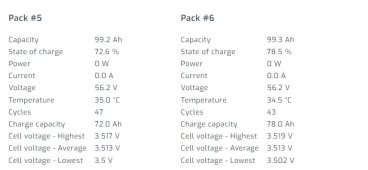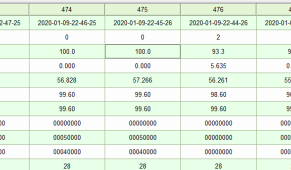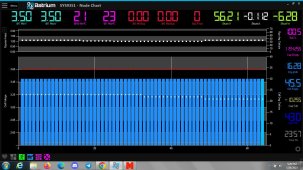elizabethii
New Member
- Joined
- Jun 3, 2022
- Messages
- 25
I have 3 EG43000EHV-48 inverters in split-phase backed up by 6 EG4 LifePower4 batteries. All of the batteries were purchased within 6 months of each other and commissioned at the same time. When charging the batteries, 1 battery appears to hit 100% while the others are around 70% charged. The DC bus voltage is at 56.2 volts, and the inverters promptly clip the power coming from the MPPTs because they're showing as charged. Ultimately, I'm leaning toward this being a BMS calibration issue, but I'm hoping for some guidance on the matter.
Below are screenshots of the pack info once the charging stops. This has been annoying me for quite a while. This morning, I tried turning the circuit breaker off on pack 3 to see if without it, the remaining batteries would get above where they're getting, but no luck. My thinking is if pack 3 were charging quicker and not discharging as deeply, without it, the bus voltage would be lower and allow the rest of them to fully charge, but that doesn't appear to be the case.


The batteries are in a rack and addressed in the order they're in the rack, top to bottom. Both positive and negative are fed into the bus bars from the top, which I know is not optimal, but if it were contributing to the uneven charge/discharge, I would expect packs 1 and 2 to be exhibiting the symptoms, not the middle. To get the rich details on the batteries through solar assistant, the inverters are in USE mode instead of the EG4-specific RS-485 protocol. Float is set to 54 and absorption is set to 56.2. I tried to run the inverters in the EG4 BMS protocol for a day to see if that fixed it, and the results appeared to be the same.
Below are screenshots of the pack info once the charging stops. This has been annoying me for quite a while. This morning, I tried turning the circuit breaker off on pack 3 to see if without it, the remaining batteries would get above where they're getting, but no luck. My thinking is if pack 3 were charging quicker and not discharging as deeply, without it, the bus voltage would be lower and allow the rest of them to fully charge, but that doesn't appear to be the case.


The batteries are in a rack and addressed in the order they're in the rack, top to bottom. Both positive and negative are fed into the bus bars from the top, which I know is not optimal, but if it were contributing to the uneven charge/discharge, I would expect packs 1 and 2 to be exhibiting the symptoms, not the middle. To get the rich details on the batteries through solar assistant, the inverters are in USE mode instead of the EG4-specific RS-485 protocol. Float is set to 54 and absorption is set to 56.2. I tried to run the inverters in the EG4 BMS protocol for a day to see if that fixed it, and the results appeared to be the same.





